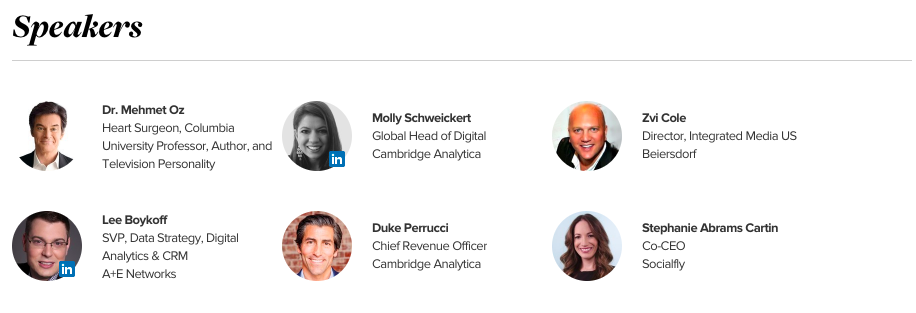
Is TV dead? This question is top-of-mind for networks, executives, and advertisers as digital continues to rise. Stephanie Cartin shared the stage alongside Dr. Mehmet Oz, Molly Schweickart, Zvi Cole, Lee Boykoff and Duke Perrucci to discuss the challenges and opportunities for the television industry now that social media has made such an impact on the space.
The importance of harnessing data for more in-depth insights was a key point throughout the panel. Social media has made it possible to target exactly who you want to see your messaging and it is critical for the television industry to keep up with the social pulse and digital interactions with their content. With so many devices, connectivity across our screens is important to deliver the most relevant messages to individuals based on their needs and wants. On what television can learn from its younger cousin, Molly Schweickart stated, “Data is not a solution, but a means to an end.” She went on to discuss how data can help television understand their audience and shared that TV can learn from data in its shortfalls as well.
As connectivity grows, the question of how we measure data holistically arises. While we are so connected, we are still largely fragmented and the industry needs more deterministic data to analyze activities across screens. An important aspect of this strategy is to determine what mediums advertisers should serve certain content. Lee Boykoff, SVP, Data Strategy, Digital Analytics & CRM, at A+E Networks, advised that brands, “Identify objectives and think about the right mix and balance for your audience.”
Looking at this from a different angle, bringing television and digital together presents a powerful synergy. Stephanie examined how TV can harness the power of social to deepen engagement by embracing influencer marketing. From a social media standpoint, this strategy is only going to become more important in marketing efforts across the board. TV can and already has begun to embrace this practice by contracting influencers to promote series premieres or finales and casting them in their projects. These influencers provide a built-in audience that will watch and share content. Stephanie also shared how social media is extending the life of a TV episode, turning it from a weekly event into a weeklong conversation. It’s imperative that TV shows have a social media strategy not only to drive viewership but also engagement.

You’ve heard this before, but content is king in the digital space. Creating platform-specific content where viewers can get to know their favorite characters helps to streamline your message. Coming from the largest skincare brand in the world, Zvi Cole, Director, Integrated Media US, Beiersdorf, expressed,”TV is still the best way to reach the largest audience but the industry can benefit from creating deeper content when and where viewers want it.” Extending programming to Facebook Live or Snapchat ensures your message resonates with audiences on each platform.
As far as the future of television, the panel agreed the industry will need to modernize to keep up with Facebook and Amazon’s emerging media businesses. One key takeaway is certain, “Quality content rises,” Dr. Oz stated, “if you’re making the best quality programming, you’ll be in a really good place.”